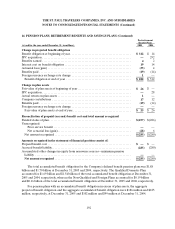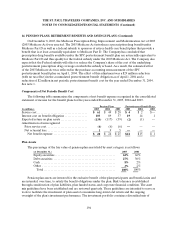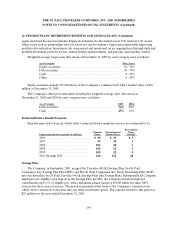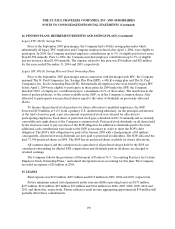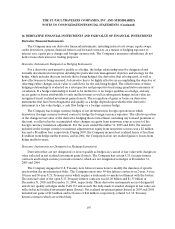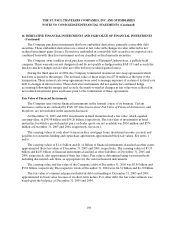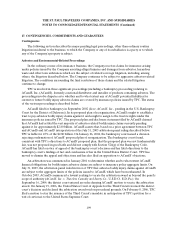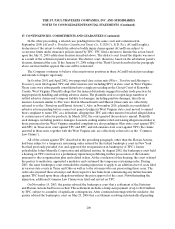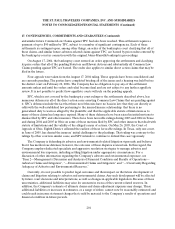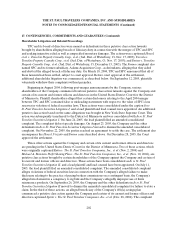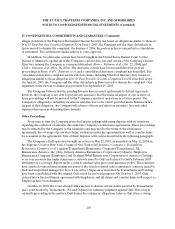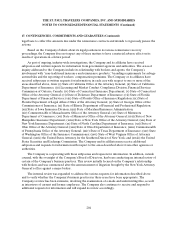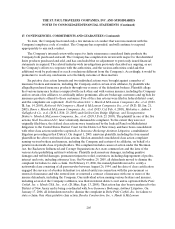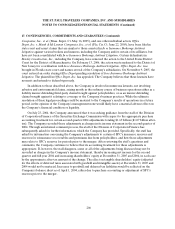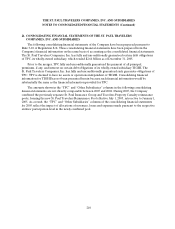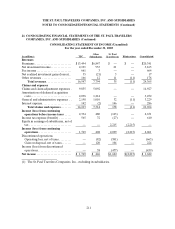Travelers 2005 Annual Report Download - page 213
Download and view the complete annual report
Please find page 213 of the 2005 Travelers annual report below. You can navigate through the pages in the report by either clicking on the pages listed below, or by using the keyword search tool below to find specific information within the annual report.THE ST. PAUL TRAVELERS COMPANIES, INC.AND SUBSIDIARIES
NOTES TO CONSOLIDATED FINANCIAL STATEMENTS (Continued)
201
17. CONTINGENCIES, COMMITMENTS AND GUARANTEES
and similar future Common Law Claims against TPC had also been reached. This settlement requires a
payment of up to $90 million by TPC, subject to a number of significant contingencies. Each of these
settlements is contingent upon, among other things, an order of the bankruptcy court clarifying that all of
these claims, and similar future asbestos-related claims against TPC, are barred by prior orders entered by
the bankruptcy court in connection with the original Johns-Manville bankruptcy proceedings.
On August 17, 2004, the bankruptcy court entered an order approving the settlements and clarifying
its prior orders that all of the pending Statutory and Hawaii Actions and substantially all Common Law
Claims pending against TPC are barred. The order also applies to similar direct action claims that may be
filed in the future.
Four appeals were taken from the August 17, 2004 ruling. These appeals have been consolidated and
are currently pending. The parties have completed briefing all of the issues anda hearing was held before
the district court on February 22, 2006. The Company has no obligation to pay any of the settlement
amounts unless and until the orders and relief become final and are not subject to any further appellate
review. It is not possible to predict how appellate courts will rule on the pending appeals.
SPC, which is not covered by the bankruptcy court rulings or the settlements described above, has
numerous defenses in all of the direct action cases asserting Common Law Claims that are pending against
it. SPC’s defenses include the fact that these novel theories have no basis in law; that they are directly at
odds with the well-established law pertaining to the insured/insurer relationship; that there is no
generalized duty to warn as alleged by the plaintiffs; and that the applicable statute of limitations as to
many of these claims has long since expired. Many of these defenses have been raised in initial motions to
dismiss filed by SPC and other insurers. There have been favorable rulings during 2003 and 2004 in Texas
and during 2004 and 2005 in Ohio on some of these motions filed by SPC and other insurers that dealt with
statute of limitations and the validity of the alleged causes of actions. On May 26, 2005, the Court of
Appeals of Ohio, EighthDistrict, affirmed the earliest of these favorable rulings. In Texas, only one court,
in June of 2005, has denied the insurers’ initial challenges to the pleadings. That ruling was contrary to the
rulings by other courts in similar cases, and SPC intends to continue to defend this case vigorously.
The Company is defending its asbestos and environmental-related litigation vigorously and believes
that it has meritorious defenses; however, the outcome of these disputes is uncertain. In this regard, the
Company employs dedicated specialists and aggressive resolution strategies to manage asbestos and
environmental loss exposure, including settling litigation under appropriate circumstances. For a
discussion of other information regarding the Company’s asbestos and environmental exposure, see
“Item 2—Management’s Discussion and Analysis of Financial Condition and Results of Operations—
Asbestos Claims and Litigation”, “—Environmental Claims and Litigation” and “—Uncertainty Regarding
Adequacy of Asbestos and Environmental Reserves.”
Currently, it is not possible to predict legal outcomes and their impact on the future development of
claims and litigation relating to asbestos and environmental claims. Any such development will be affected
by future court decisions and interpretations, as well as changes in applicable legislation.Because of these
uncertainties, additional liabilities may arise for amounts in excess of the current related reserves. In
addition, the Company’s estimate of ultimate claims and claim adjustment expenses may change. These
additional liabilities or increases in estimates, or a range of either, cannot now be reasonably estimated and
could result in income statement charges that could be material to the Company’s results of operations and
financial condition in future periods.
(Continued)



